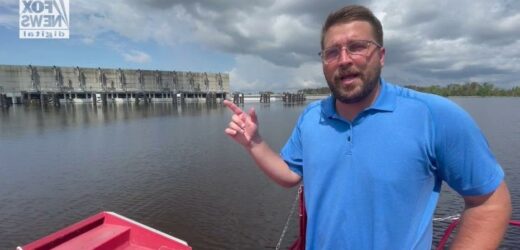Hurricane Ida Recovery: Part 2 – Louisiana mayor claims construction of levee system protecting New Orleans was disastrous for his town
Jean Lafitte, LA – This is part two of a Fox News Digital Originals series about the ongoing struggle for residents to recover from the destruction caused by Hurricane Ida in southern Louisiana.
A levee system the federal government built after Hurricane Katrina helped destroy a small Louisiana town, according to the community’s mayor.
The system was intended to safeguard New Orleans during severe weather. But many small towns south of the city, including Jean Lafitte, were not incorporated into the system, leaving them vulnerable to flooding and storm surge.
“We lost inside the levee protection by inches,” Jean Lafitte Mayor Tim Kerner told Fox News.
The Hurricane and Storm Damage Risk Reduction System is a series of levees, floodwalls, gauge structures and pump stations that form a 133-mile perimeter around Greater New Orleans. It includes the West Closure Complex – considered the largest water pump in the world.
During Hurricane Ida, the pump was turned on to reduce the risk of storm surge.
Kerner said the pump dumped the equivalent of an Olympic-sized swimming pool onto his town every four seconds during the storm.
“According to the gauges, that pump has increased our levels,” he told Fox News. “We lost our schools, our government buildings and hundreds of homes.”
“So, I want them to take some responsibility and invest in here because we’re not going anywhere,” Kerner continued.
Jean Lafitte is home to about 10,000 residents. It is also part of Jefferson Parish, which includes the Greater New Orleans area.
“We have areas in Jefferson Parish, what we call outside the levee protection system,” Jefferson Parish President Cynthia Lee Sheng told Fox News. “These are our southernmost areas, Grand Isle is right on the Gulf and then here’s Lafitte that really are our most vulnerable areas of the parish, because they just don’t have the levee protection system.”
“They’re not protected by the pumping capacity, they don’t have that perimeter defense and they’re very vulnerable to storm surge as well,” she continued.
House Minority Whip Steve Scalise, R-La., who represents Lower Jefferson Parish, said the relationship between local leaders and the Army Corps of Engineers has always been complicated.
“It seems like any member of Congress you talk to, Republican or Democrat, they’ve got some kind of frustration with that relationship on the ground with the Corps of Engineers because of how projects work and come out of Washington with a lot of red tape,” Scalise told Fox News.
“I’m going to be fighting to make sure they’re not left behind, but it’s a valid concern that gets raised in times like this,” he continued.
The Army Corps of Engineers will evaluate what happened in Jean Lafitte and other areas outside the system, according to corps spokesman Ricky Boyett. He said there are lessons to be learned after every storm.
“It’s not that they’re expendable,” Boyett told Fox News. “There’s a limited amount of dollars, what you need to do is find that manner in which you’re getting the best bang for the taxpayers’ dollars nationwide.”
“That’s not to say that there can’t be state, local or even other federal programs that can help in that area, but it is a consideration that you have to consider the nation as a whole,” he added.
Two hours south of Jean Lafitte is the town of Grand Isle. Hurricane Ida made landfall 10 miles southwest of the small barrier island with 150 mph winds. During the storm, several sand or “burrito” levees built by the Army Corps of Engineers failed, causing massive destruction.
Grand Isle Mayor David Camardelle said the catastrophe could have been avoided.
“We need more rocks on the coast,” he told Fox News. “We’re like the soldiers in Iraq, we’re on the front line.”
“If them rocks would have been on that area, three-quarters of the island would have been protected,” Camardelle added.
Camardelle tells Fox News he has been asking for $50 million to build rock walls along his island that would serve as breakwaters during a storm, but the Army Corps of Engineers has not committed to the project.
“With regards to Grand Isle, we are committed to using the funds we do have to put those breakwaters in,” Boyett said. “I wouldn’t say we’re looking at something like a feasibility study in which you’re trying to determine whether there’s a project there, we’re looking at it from what’s the best project to put in place, and we are considering a sand dune, maybe a clay dune, or a rock, and so those are all going to be considered.”
Camardelle told Fox News: “I just don’t have time to study no more, you know, just come in and bring barges of rocks where they got to be. I need 32 segments.”
To date, the Army Corps of Engineers has built five rock segments to protect Grand Isle. They have money to build three more, but the mayor said that’s not enough to save his town.
“I’m not giving up, as long as there’s one grain of sand on this island, we are going to plant the American flag and we’ll stay strong,” Camardelle said.
Source: Read Full Article



